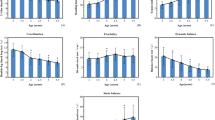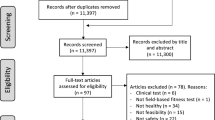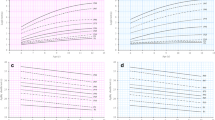Abstract
Background
Physical fitness is a powerful health marker in childhood and adolescence, and it is reasonable to think that it might be just as important in younger children, i.e. preschoolers. At the moment, researchers, clinicians and sport practitioners do not have enough information about which fitness tests are more reliable, valid and informative from the health point of view to be implemented in preschool children.
Objective
Our aim was to systematically review the studies conducted in preschool children using field-based fitness tests, and examine their (1) reliability, (2) validity, and (3) relationship with health outcomes. Our ultimate goal was to propose a field-based physical fitness-test battery to be used in preschool children.
Data Sources
PubMed and Web of Science.
Study Eligibility Criteria
Studies conducted in healthy preschool children that included field-based fitness tests.
Study Appraisal and Synthesis Methods
When using PubMed, we included Medical Subject Heading (MeSH) terms to enhance the power of the search. A set of fitness-related terms were combined with ‘child, preschool’ [MeSH]. The same strategy and terms were used for Web of Science (except for the MeSH option). Since no previous reviews with a similar aim were identified, we searched for all articles published up to 1 April 2014 (no starting date). A total of 2,109 articles were identified, of which 22 articles were finally selected for this review.
Results
Most studies focused on reliability of the fitness tests (n = 21, 96 %), while very few focused on validity (0 criterion-related validity and 4 (18 %) convergent validity) or relationship with health outcomes (0 longitudinal and 1 (5 %) cross-sectional study). Motor fitness, particularly balance, was the most studied fitness component, while cardiorespiratory fitness was the least studied. After analyzing the information retrieved in the current systematic review about fitness testing in preschool children, we propose the PREFIT battery, field-based FITness testing in PREschool children. The PREFIT battery is composed of the following tests: the 20 m shuttle-run test for assessing cardiorespiratory fitness, the handgrip-strength and the standing long-jump tests for assessing musculoskeletal fitness, and the 4 × 10 m shuttle run and the one-leg-stance tests for assessing motor fitness, i.e. speed/agility and balance, respectively. The rationale for the selection of each of the tests included in the PREFIT battery is provided in this review, as well as directions for future research.
Limitations
Levels of evidence based on quality assessment of selected studies could not be constructed due to the limited number of studies identified for each test.
Conclusions
The present systematic review has identified a need for further research on the validity of fitness tests in preschool children, as well as on their relationship with health. Due to this limited information, the PREFIT battery hereby proposed is based on the output of the current systematic review in preschool children, together with existing evidence in older children and adolescents. While we wait for more evidence to be accumulated in preschool children, the PREFIT battery hereby proposed is a useful tool for assessing physical fitness in children aged 3–5 years.


Similar content being viewed by others
References
Ortega FB, Ruiz JR, Castillo MJ, et al. Physical fitness in childhood and adolescence: a powerful marker of health. Int J Obes (Lond). 2008;32(1):1–11.
Ruiz JR, Castro-Pinero J, Artero EG, et al. Predictive validity of health-related fitness in youth: a systematic review. Br J Sports Med. 2009;43(12):909–23.
Smith JJ, Eather N, Morgan PJ, et al. The health benefits of muscular fitness for children and adolescents: a systematic review and meta-analysis. Sports Med. 2014;44(9):1209–23.
Ortega FB, Labayen I, Ruiz JR, et al. Improvements in fitness reduce the risk of becoming overweight across puberty. Med Sci Sports Exerc. 2011;43(10):1891–7.
Ortega FB, Silventoinen K, Tynelius P, et al. Muscular strength in male adolescents and premature death: cohort study of one million participants. BMJ. 2012;345:e7279.
Artero EG, Espana-Romero V, Castro-Pinero J, et al. Reliability of field-based fitness tests in youth. Int J Sports Med. 2011;32(3):159–69.
Castro-Pinero J, Artero EG, Espana-Romero V, et al. Criterion-related validity of field-based fitness tests in youth: a systematic review. Br J Sports Med. 2010;44(13):934–43.
Ruiz JR, Castro-Pinero J, Espana-Romero V, et al. Field-based fitness assessment in young people: the ALPHA health-related fitness test battery for children and adolescents. Br J Sports Med. 2011;45(6):518–24.
IOM (Institute of Medicine). Fitness measures and health outcomes in youth. Washington, DC: The National Academies Press; 2012.
National Library of Medicine. Medical Subject Headings. MeSH Descriptor Data. 2014 [cited 2014 Sept 14]. Available from: http://www.nlm.nih.gov/cgi/mesh/2014/MB_cgi?mode=&index=2553&field=all&HM=&II=&PA=&form=&input=.
Polit DF, Beck CT. Nursing research: Generating and assessing evidence for nursing practice. 9th ed. Philadelphia: Wolters Klower Health, Lippincott Williams and Wilkins; 2012.
Campbell DT, Fiske DW. Convergent and discriminant validation by the multitrait-multimethod matrix. Psychol Bull. 1959;56(2):81–105.
Taylor HL, Buskirk E, Henschel A. Maximal oxygen intake as an objective measure of cardio-respiratory performance. J Appl Physiol. 1955;8(1):73–80.
Caspersen CJ, Powell KE, Christenson GM. Physical activity, exercise, and physical fitness: definitions and distinctions for health-related research. Public Health Rep. 1985;100(2):126–31.
Burgi F, Meyer U, Granacher U, et al. Relationship of physical activity with motor skills, aerobic fitness and body fat in preschool children: a cross-sectional and longitudinal study (Ballabeina). Int J Obes (Lond). 2011;35(7):937–44.
Burgi F, Meyer U, Niederer I, et al. Socio-cultural determinants of adiposity and physical activity in preschool children: a cross-sectional study. BMC Public Health. 2010;10:733.
Ebenegger V, Marques-Vidal P, Kriemler S, et al. Differences in aerobic fitness and lifestyle characteristics in preschoolers according to their weight status and sports club participation. Obes Facts. 2012;5(1):23–33.
Niederer I, Kriemler S, Gut J, et al. Relationship of aerobic fitness and motor skills with memory and attention in preschoolers (Ballabeina): a cross-sectional and longitudinal study. BMC Pediatr. 2011;11:34.
Niederer I, Kriemler S, Zahner L, et al. BMI group-related differences in physical fitness and physical activity in preschool-age children: a cross-sectional analysis. Res Q Exerc Sport. 2012;83(1):12–9.
Puder JJ, Marques-Vidal P, Schindler C, et al. Effect of multidimensional lifestyle intervention on fitness and adiposity in predominantly migrant preschool children (Ballabeina): cluster randomised controlled trial. BMJ. 2011;343:d6195.
Reeves L, Broeder CE, Kennedy-Honeycutt L, et al. Relationship of fitness and gross motor skills for five- to six-yr.-old children. Percept Mot Skills. 1999;89(3 Pt 1):739–47.
Rikli RE, Petray C, Baumgartner TA. The reliability of distance run tests for children in grades K-4. Res Q Exerc Sport. 1992;63(3):270–6.
Bénéfice E, Fouere T, Malina RM. Early nutritional history and motor performance of Senegalese children, 4–6 years of age. Ann Hum Biol. 1999;26(5):443–55.
Oja L, Jürimäe T. Assessment of motor ability of 4- and 5-year-old children. Am J Hum Biol. 1997;9(5):659–64.
Molenaar HM, Zuidam JM, Selles RW, et al. Age-specific reliability of two grip-strength dynamometers when used by children. J Bone Joint Surg Am. 2008;90(5):1053–9.
Krombholz H. Testbatterie zur Erfassung motorischer Leistungen im Vorschulalter MoTB 3–7. Beschreibung, Gütekriterien, Normwerte und ausgewählte Ergebnisse [A test battery for measuring motor performance of preschool children MoTB 3–7. Description, quality criteria, norms, and selected results]. 2011. Available at: http://psydok.sulb.uni-saarland.de/volltexte/2011/2711/
Molenaar HM, Selles RW, Schreuders TA, et al. Reliability of hand strength measurements using the Rotterdam Intrinsic Hand Myometer in children. J Hand Surg Am. 2008;33(10):1796–801.
Rose KJ, Burns J, Ryan MM, et al. Reliability of quantifying foot and ankle muscle strength in very young children. Muscle Nerve. 2008;37(5):626–31.
Koslow RE. Sit and reach flexibility measures for boys and girls aged 3 through 8 years. Percept Mot Skills. 1987;64(3):1103–6.
Deitz JC, Kartin D, Kopp K. Review of the Bruininks–Oseretsky Test of Motor Proficiency, Second Edition (BOT-2). Phys Occup Ther Pediatr. 2007;27(4):87–102.
Nguyen T, Obeid J, Timmons BW. Reliability of fitness measures in 3- to 5-year-old children. Pediatr Exerc Sci. 2011;23(2):250–60.
Hua J, Gu G, Meng W, et al. Age band 1 of the Movement Assessment Battery for Children-Second Edition: exploring its usefulness in mainland China. Res Dev Disabil. 2013;34(2):801–8.
Kasuga K, Demura S, Aoki H, et al. Sex and age-level differences of walking time in preschool children on an obstacle frame. J Physiol Anthropol. 2012;31:8.
De Kegel A, Baetens T, Peersman W, et al. Ghent developmental balance test: a new tool to evaluate balance performance in toddlers and preschool children. Phys Ther. 2012;92(6):841–52.
Smits-Engelsman BC, Niemeijer AS, van Waelvelde H. Is the Movement Assessment Battery for Children-2nd edition a reliable instrument to measure motor performance in 3 year old children? Res Dev Disabil. 2011;32(4):1370–7.
Ellinoudis T, Evaggelinou C, Kourtessis T, et al. Reliability and validity of age band 1 of the Movement Assessment Battery for Children–second edition. Res Dev Disabil. 2011;32(3):1046–51.
Sun SH, Zhu YC, Shih CL, et al. Development and initial validation of the Preschooler Gross Motor Quality Scale. Res Dev Disabil. 2010;31(6):1187–96.
Kroes M, Vissers YL, Sleijpen FA, et al. Reliability and validity of a qualitative and quantitative motor test for 5- to 6-year-old children. Eur J Paediatr Neurol. 2004;8(3):135–43.
Broadstone BJ, Westcott SL, Deitz JC. Test–retest reliability of two tiltboard tests in children. Phys Ther. 1993;73(9):618–25.
Greenspan KA. Relationships among age, sex, and lateral dominance for 3- to 6-year-old children performing unilateral stance. Percept Mot Skills. 1990;71(2):615–23.
Kim CI, Han DW, Park IH. Reliability and validity of the Test of Gross Motor Development-II in Korean preschool children: applying AHP. Res Dev Disabil. 2014;35(4):800–7.
Cools W, Martelaer KD, Samaey C, et al. Movement skill assessment of typically developing preschool children: a review of seven movement skill assessment tools. J Sports Sci Med. 2009;8(2):154–68.
Lee-Valkov PM, Aaron DH, Eladoumikdachi F, et al. Measuring normal hand dexterity values in normal 3-, 4-, and 5-year-old children and their relationship with grip and pinch strength. J Hand Ther. 2003;16(1):22–8.
Butterfield SA, Lehnhard RA, Coladarci T. Age, sex, and body mass index in performance of selected locomotor and fitness tasks by children in grades K-2. Percept Mot Skills. 2002;94(1):80–6.
Butterfield SA, Lehnhard RA, Loovis EM, et al. Grip strength performances by 5- to 19-year-olds. Percept Mot Skills. 2009;109(2):362–70.
Haishi K, Okuzumi H, Kokubun M, et al. Verbal regulation of grip force in preschoolers. Percept Mot Skills. 2009;108(2):540–8.
Molenaar HM, Selles RW, Zuidam JM, et al. Growth diagrams for grip strength in children. Clin Orthop Relat Res. 2010;468(1):217–23.
Yoshizawa S, Ishizaki T, Honda H. Physical fitness of children aged 5 and 6 years. J Hum Ergol (Tokyo). 1977;6(1):41–51.
Fjortoft I, Pedersen AV, Sigmundsson H, et al. Measuring physical fitness in children who are 5–12 years old with a test battery that is functional and easy to administer. Phys Ther. 2011;91(7):1087–95.
Duger T, Bumin G, Uyanik M, et al. The assessment of Bruininks–Oseretsky test of motor proficiency in children. Pediatr Rehabil. 1999;3(3):125–31.
Venetsanou F, Kambas A, Aggeloussis N, et al. Motor assessment of preschool aged children: a preliminary investigation of the validity of the Bruininks–Oseretsky test of motor proficiency—short form. Hum Mov Sci. 2009;28(4):543–50.
Woll A, Worth A, Mundermann A, et al. Age- and sex-dependent disparity in physical fitness between obese and normal weight children and adolescents. J Sports Med Phys Fitness. 2013;53(1):48–55.
Woll A, Kurth BM, Opper E, et al. The ‘Motorik-Modul’ (MoMo): physical fitness and physical activity in German children and adolescents. Eur J Pediatr. 2011;170(9):1129–42.
Krombholz H. Physical performance in relation to age, sex, birth order, social class, and sports activities of preschool children. Percept Mot Skills. 2006;102(2):477–84.
Kambas A, Aggeloussis N. Construct validity of the Bruininks–Oseretsky Test of Motor Proficiency-short form for a sample of Greek preschool and primary school children. Percept Mot Skills. 2006;102(1):65–72.
Welon Z, Sekita B. Physical fitness, body size, and body build in pre-school children. Stud Phys Anthrop. 1975;2:25–32.
Kondric M, Trajkovski B, Strbad M, et al. Anthropometric influence on physical fitness among preschool children: gender-specific linear and curvilinear regression models. Coll Antropol. 2013;37(4):1245–52.
Atwater SW, Crowe TK, Deitz JC, et al. Interrater and test–retest reliability of two pediatric balance tests. Phys Ther. 1990;70(2):79–87.
An MH, Yi CH, Jeon HS, et al. Age-related changes of single-limb standing balance in children with and without deafness. Int J Pediatr Otorhinolaryngol. 2009;73(11):1539–44.
Nemet D, Geva D, Eliakim A. Health promotion intervention in low socioeconomic kindergarten children. J Pediatr. 2011;158(5):796–801 e1.
Booth ML, Macaskill P, Phongsavan P, et al. Methods of the NSW Schools Fitness and Physical Activity Survey, 1997. J Sci Med Sport. 1998;1(2):111–24.
Reuben DB, Magasi S, McCreath HE, et al. Motor assessment using the NIH Toolbox. Neurology. 2013;80(11 Suppl 3):S65–75.
Artero EG, Espana-Romero V, Castro-Pinero J, et al. Criterion-related validity of field-based muscular fitness tests in youth. J Sports Med Phys Fitness. 2012;52(3):263–72.
Castro-Pinero J, Ortega FB, Artero EG, et al. Assessing muscular strength in youth: usefulness of standing long jump as a general index of muscular fitness. J Strength Cond Res. 2010;24(7):1810–7.
Espana-Romero V, Ortega FB, Vicente-Rodriguez G, et al. Elbow position affects handgrip strength in adolescents: validity and reliability of Jamar, DynEx, and TKK dynamometers. J Strength Cond Res. 2010;24(1):272–7.
Espana-Romero V, Artero EG, Santaliestra-Pasias AM, et al. Hand span influences optimal grip span in boys and girls aged 6–12 years. J Hand Surg [Am]. 2008;33(3):378–84.
Ruiz JR, Espana-Romero V, Ortega FB, et al. Hand span influences optimal grip span in male and female teenagers. J Hand Surg [Am]. 2006;31(8):1367–72.
Hager-Ross C, Rosblad B. Norms for grip strength in children aged 4–16 years. Acta Paediatr. 2002;91(6):617–25.
Vicente-Rodriguez G, Rey-Lopez JP, Ruiz JR, et al. Interrater reliability and time measurement validity of speed–agility field tests in adolescents. J Strength Cond Res. 2011;25(7):2059–63.
Kakebeeke TH, Caflisch J, Chaouch A, et al. Neuromotor development in children. Part 3: motor performance in 3- to 5-year-olds. Dev Med Child Neurol. 2013;55(3):248–56.
Benefice E, Cames C. Physical activity patterns of rural Senegalese adolescent girls during the dry and rainy seasons measured by movement registration and direct observation methods. Eur J Clin Nutr. 1999;53(8):636–43.
Bland JM, Altman DG. Statistical methods for assessing agreement between two methods of clinical measurement. Lancet. 1986;1(8476):307–10.
Landis JR, Koch GG. The measurement of observer agreement for categorical data. Biometrics. 1977;33:159–74.
Acknowledgments
We thank Vanesa España-Romero and David Jiménez-Pavón from the University of Cádiz, Spain, and Manuel J. Castillo, from the University of Granada, Spain, for the valuable comments on an earlier draft. Francisco B. Ortega and Jonatan R. Ruiz were supported by grants from the Spanish Ministry of Science and Innovation (RYC-2011-09011 and RYC-2010-05957, respectively). All the authors have declared they have no conflicts of interest.
Author information
Authors and Affiliations
Corresponding author
Electronic Supplementary Material
Below is the link to the electronic supplementary material.
Rights and permissions
About this article
Cite this article
Ortega, F.B., Cadenas-Sánchez, C., Sánchez-Delgado, G. et al. Systematic Review and Proposal of a Field-Based Physical Fitness-Test Battery in Preschool Children: The PREFIT Battery. Sports Med 45, 533–555 (2015). https://doi.org/10.1007/s40279-014-0281-8
Published:
Issue Date:
DOI: https://doi.org/10.1007/s40279-014-0281-8




